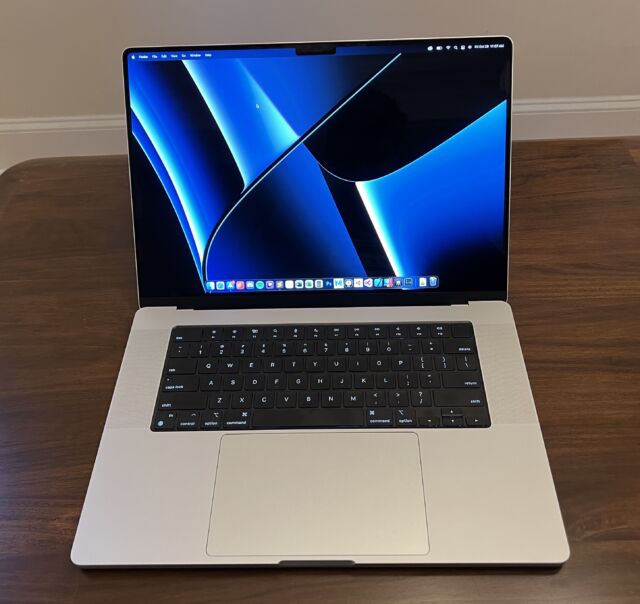2021 MacBook Pro review: Yep, it’s what you’ve been waiting for

Apple MacBook Pro (2021)
Apple has long offered an application called Time Machine that lets you revert the software on your computer to the state it was in before something went seriously wrong. In many ways, the new MacBook Pro is a hardware Time Machine of its own; you could say it makes it seem like the past five years never happened.
The 2021 MacBook Pro is notably bulkier, more flexible, and more powerful than its predecessor. It clicks “revert” on a whole bunch of changes that have been generally unpopular, like the inclusion of the Touch Bar in place of physical function keys and the singular focus on Thunderbolt as the port of choice.
The new laptop also has the most advanced CPU, GPU, and NPU ever included in a consumer laptop and display technology that has never been seen in mainstream consumer products. So maybe it’s not so much like the past five years never happened; it’s more like we’ve slipstreamed into an alternate timeline where Apple never changed course at a critical juncture when a lot of people felt it shouldn’t have.
There has been speculation about whether this is the first laptop designed without a lot of direct involvement by long-time Steve Jobs partner Jony Ive, who left Apple not all that long ago. Maybe, maybe not. Given all that goes into designing these machines over several years, it’s probably not that clean-cut.
But Ive’s level of involvement aside, rest assured: If you didn’t like the direction Apple has been taking with the MacBook Pro for the last five years, this laptop mostly feels like an explicit apology for all of that. The result: It’s the best laptop money can buy for many use cases, provided you have a lot of money.
Table of Contents
Specifications
| Specs at a glance: 2021 14- and 16-inch MacBook Pro | |
|---|---|
| OS | macOS Monterey 12.0.1 |
| CPU | Apple M1 Pro (14-inch), M1 Max (16-inch) |
| RAM | 32GB (14-inch), 64GB (16-inch) |
| GPU | Apple M1 Pro (14-inch) M1 Max (16-inch) |
| HDD | 1TB (14-inch), 2TB (16-inch) |
| Networking | Wi-Fi 6; Bluetooth 5.0 |
| Ports | 3x Thunderbolt, 3.5 mm headphone, SD card slot, HDMI, MagSafe |
| Warranty | 1 year, or 3 years with AppleCare+ |
| Price as reviewed | $2,899 (14-inch), $3,299 (16-inch) |
As usual, we’ll start with the specs. And there’s a lot to talk about here.
Display
The MacBook Pro comes in two sizes: 14-inch and 16-inch. Technically, the screen sizes are 14.2 inches (with a 3024×1964 pixel resolution) and 16.2 inches (3456×2234). And yes, there’s a camera notch—we’ll get to that shortly.
The display is one of the key value propositions of this machine. It’s in an entirely different category than most other consumer laptop displays, thanks in part to Mini LED tech, which has been showing up in high-end TVs and Apple’s ultra-pricy Pro Display XDR monitor.
Mini LED enables local dimming of hundreds or even thousands of dimming zones, so while it’s still an LCD screen, in optimal conditions, you can get similar contrast and black levels to what you might see in an OLED screen but with better brightness and no burn-in risk.

Apple claims it can achieve 1,600 nits of peak brightness on highlights, or 1,000 nits of sustained full-screen brightness. That’s frankly nuts for a laptop screen; it’s comparable to what we see in the most expensive HDR television sets. This is a huge deal for people in certain fields who want to do things like HDR color grading on the go, which hasn’t really been possible without impractical and ludicrously expensive mobile workstations. For the rest of us, it means higher brightness to fight the sunlight or overhead lights and outstanding contrast and highlights in HDR video content like movies and TV shows.
Apple is known for calibrating its displays well before shipping them, and you can for the first time create custom color profiles right in macOS’s System Preferences pane. This won’t matter to most people, but for a certain crowd of photo- and video-editing professionals, it could be a really nice addition.
All that together makes this the best display I’ve ever seen in a laptop.
It’s not always flawless, though. You’ll occasionally notice LCD-type blooming, especially in letterboxed images like 16:9 videos. It’s just markedly less pronounced than it was in prior MacBook displays.
The 14-inch model could benefit from a little more screen real estate, too, given the tasks it’s meant for. As has long been the case with Apple’s “Retina” displays, the actual screen space is not what you’d expect from the native resolution, as there’s some scaling going on.

By default, the 14-inch’s desktop “looks like” 1512×982 in terms of available space for windows. You can bump that up a little to 1800×1169. (The System Preferences panel warns this may affect performance, but we haven’t noticed anything issues.) There are also two lower resolutions—1147×745 and 1024×665—that make everything bigger but a bit fuzzier.
As for the 16-inch model, the default mode “looks like” 1728×1117, and there’s again a more spacious scaled option at 2056×1329. The downscaled sizes include 1496×967, 1312×848, and 1168×755. The 16-inch gives you enough space in its default scaling setting and plenty in the one that’s a step above it. But to me, the 14-inch feels a bit cramped unless it’s on the highest setting.
Based on what Apple has said and as far as we can tell, there’s no substantial difference between the 14-inch and 16-inch displays besides screen size. It could be that the 14-inch model has fewer Mini LED zones, but it looks so good as it is that it will be hard for most people to see.
https://arstechnica.com/?p=1808619